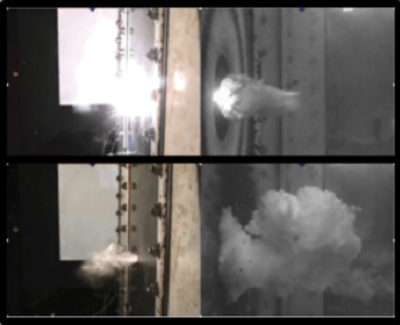Meshing, visualization tests show promise
By JAMES MASTERS AND CAROLYN WOEBER|December 2017
The Meshing, Visualization and Computational Environments Technical Committee explores the application of computer science to pre-processing, post-processing and infrastructure in support of computational simulation in the aerospace community.
One of the first higher-order finite-element full aircraft simulations was presented in June at the 1st AIAA Geometry and Mesh Generation Workshop, where members of industry, academia and government from several technical committees and multiple countries came together to advance goals and address concerns laid out in NASA’s CFD Vision 2030 Study. New techniques in mesh adaptation were also showcased and significant progress was made in higher order mesh generation. In addition to providing a datum against which future progress in geometry modeling and mesh generation can be measured, the workshop provided a model for sharing results and best practices within the computational fluid dynamics community that will continue into the future.
Supported by grants from the U.S. Department of Energy Office of Advanced Scientific Computing Research, Intelligent Light completed work toward developing CFD methods to meet the CFD 2030 vision in December. Among these were new methods for visualizing high order results and curved grids and a web-based uncertainty quantification framework that allows users to create two-dimensional plots and three-dimensional visualizations of CFD solutions and manage and explore associated uncertainty.
Pointwise completed a Commercialization Readiness Pilot contract in August for the U.S. Air Force to develop an integrated overset meshing and grid assembly capability. Software was provided to the Air Force that included capabilities such as improved meshing and remediation, hierarchical frameworks, examine enhancements and mesh assembly integration. Part of the improved meshing capability was a mesh smoothing method for the viscous layer prism extrusion process. The formulation and examples that first demonstrated this capability were presented in the paper “Optimization-Based Smoothing for Extruded Meshes,” which was this year’s recipient of the Meshing, Visualization and Computational Environments Shahyar Pirzadeh Best Paper Award.
Mesh adaptation and smoothing, where the clustering and point-density of the computational mesh is driven by the physics of the flow field or geometric considerations, continues to be a topic of considerable interest. New adaptation techniques, developed by Inria (The French National Institute for Research in Computer Science and Control) and Boeing, were shown to improve CFD results. These techniques impacted solutions at several validation workshops including Sonic Boom Prediction in January and High Lift Prediction in June.
Use of in-situ data processing, in which data is intelligently reduced, analyzed, transformed and indexed while still in memory before being written to disk or transferred over networks, continues to expand. A tool that gained traction this year was the open source visualization tool VisIt, along with Libsim, an associated library used to instrument simulations for in-situ visualization. These tools were leveraged to enable JAXA, the Japan Aerospace Exploration Agency, to instrument its CFD solver to study launch vehicle acoustics and the University of Wyoming to instrument its high order computational framework to analyze a 1 billion degree-of-freedom wind turbine farm simulation.
A core part of the CFD process is the computational environment in which the simulation takes place. While computational environments are not as easy to define as meshing and visualization, an important aspect is the framework that initializes, executes and manages the various tasks in the process. One of the quickest growing frameworks, both in terms of user penetration with 500-plus active licenses and in terms of capability, is Kestrel, which saw several updates in 2017, including simplified boundary condition handling and the incorporation of a new visualization manager. These new capabilities directly assisted CREATE (Computational Research and Engineering Acquisition Tools and Environments) in its mission to improve the Department of Defense acquisition process.



































